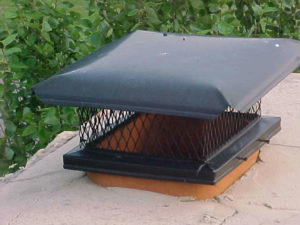While our chimneys may seem simple, they are actually made of a number of different components that each play an important role. One of the most important – but often ignored – parts of the chimney system is the chimney cap. Chimney caps protect the fireplace from water damage, animal entry, and debris buildup; because they cannot be seen from street level, however, many homeowners do not know when their chimney caps need to be repaired or replaced.
 What is a chimney cap?
What is a chimney cap?
A chimney cap is a metal cover that protects the top of the chimney structure as well as the top of the flue. Made of out metal, chimney caps have a solid hood with wire or mesh sides; this allows smoke and gasses to safely draft out of the fireplace while preventing animals, debris, and water from getting in.
The price range for chimney caps varies by the quality and materials; a new chimney cap can range anywhere from $50 to $1500 dollars. Differences in chimney caps include double flue caps, heavy meshed bolted down caps, small venting caps, chase pan covers, and top-mounted dampers. Other pricing differences include access to the roofline, extra visits needed for measurements or installation, or the need of additional access equipment.
Choosing the right chimney cap
There is not one “standard” chimney cap. There are a variety of chimney caps – including custom chimney caps designed specifically for your unique chimney size and shape. Most homes still have their original, factory-built chimney cap. While effective, they can rust and deteriorate over time.
At Jack Pixley Sweeps, we install a variety of chimney caps; this includes small furnace flue caps, standard metal rain covers and screencaps, top-mounted dampers, and large chase pan caps that are found on manufactured fireplaces.
The type of chimney cap your home requires depends on a number of factors including the type of fireplace, fuel source, size of the chimney, and age of the fireplace system. We often recommend stainless steel chimney caps to our customers; stainless steel prevents future rusting and can be attached securely to prevent movement in severe weather.
Likewise, stainless steel chimney caps are also durable enough to prevent animal entry. Raccoons are notorious at clawing, biting, and scratching at chimney caps to create gaps in the mesh; once they have damaged the chimney cap, raccoons can access the chimney and build a nest for their young in the flue.
Consider switching to a top-mounted damper!
While we recommend that every chimney has a chimney cap, there is another option: a top-mounted damper. Top-mounted dampers replace the traditional throat dampers that most fireplaces have while also replacing the need for a chimney cap.
Top-mounted dampers are located at the top of the chimney structure in place of a traditional chimney cap. When closed, the entire chimney and flue is sealed from outside air; this prevents outside air – as well as animals and debris – from entering the chimney. When the fireplace is in use, the damper can be easily opened to allow smoke and gasses to safely draft out of the chimney.
Top-mounted dampers are considered an energy-efficient chimney upgrade. While installing a top-mounted damper does not make a fireplace itself more efficient, it can help lower heating and cooling costs for your home. Because the entire flue is closed from outside air, the air temperature in the flue is not affected by the air temperature outside. This helps keep the rooms surrounding the flue at a more consistent temperature, reducing the utility costs associated with heating and cooling the home.
Why do I need a chimney cap?
Chimney caps serve an important purpose; every chimney needs one! Whether you choose a standard chimney cap, have one custom-designed for your specific chimney, or opt to install a top-mounted damper, the following are three of the major reasons all chimneys need a chimney cap.
- Keep out animals. Animals love chimneys! Birds, squirrels, raccoons, and other animals view chimneys as a safe and protected space to build nests, birth young, and hide from predators. Unfortunately, an uncapped chimney – or a chimney with a damaged chimney cap – is an open invitation for animals to nest in your flue. Animals in the flue can cause damage to the chimney system, create blockages that prevent proper drafting, increase the risk of chimney fire due to dried nesting materials, or even expose members occupants of the house to insects or disease.
- Prevent debris from blocking the chimney. Without a chimney cap, chimneys can be prone to blockages from leaves and twigs; even stray balls, frisbees, or blowing plastic bags can fall into an uncapped chimney! This debris can then cause chimney blockages; a blockage can prevent smoke and gas from drafting properly, keep fires from burning as the chimney cannot draw in outside air, or cause smoke to back up into the room.
- Prevent water damage. The exterior of the chimney is designed to withstand the elements; internal chimney components are designed to withstand heat. If the chimney cap is missing or damaged, water can severely damage interior fireplace components. Cracks to the flue liner, rust on the damper, or water in the firebox can all indicate a leaky chimney. Likewise, water in the cold, dark flue can lead to mold or mildew growth if the source of the leak is not repaired.
A well-fitted, well-constructed chimney cap can help keep your fireplace system in good condition for years to come. For more information on the importance of the chimney cap or to have your chimney cap inspected contact Jack Pixley Sweeps today!
